【C++】cin、cin.get()、cin.getline()、getline()的区别
本文转载自:https://blog.csdn.net/a3192048/article/details/80303547
测试平台g++ 5.4.0和VS2015社区版。
输入原理简述:
程序的输入都建有一个缓冲区,即输入缓冲区。每次输入过程是这样的,当一次键盘输入结束时会将输入的数据存入输入缓冲区,而cin函数直接从输入缓冲区中取数据(cin读取数据是从第一个非空白字符开始到下一个空白字符结束)。正因为cin函数是直接从缓冲区取数据的,所以有时候当缓冲区中有残留数据时,cin函数会直接取得这些残留数据而不会请求键盘输入。
比如下面的例子:
-
void test_input()
-
{
-
string str;
-
cout<<
"cin的测试:"<
-
cin>>str;
-
cout<
-
cin>>str;
-
cout<
-
}

由于cin在遇到空格/tab时,就会停止读取,所以如果我在第一次输入时,利用空格隔开两个字符串,那么cin在第一次取的时候,只会读取前一个字符串,到空格结束,此时缓冲区还保留着前面输入的第二个字符串,那么第二次cin就会直接从缓冲区取残留数据,而不会请求输入。
当然对于以上的情况,也有解决的方案,那就是在第二次调用cin>>str之前通过cin.sync()来清空输入缓冲区,看一下下面的例子,此处不赘述:
-
void test_input()
-
{
-
string str;
-
cout<<
"cin的测试:"<
-
cin>>str;
-
cin.
sync();
-
cout<
-
cin>>str;
-
cout<
-
}

各种输入方法简介:
1、cin>>
根据cin>>sth 中sth的变量类型读取数据,这里变量类型可以为int,float,char,char*,string等诸多类型。这一输入操作,在遇到结束符(Space、Tab、Enter)就结束,且对于结束符,并不保存到变量中。注意:最后一个enter也在缓冲区。
-
void test_input()
-
{
-
char ch;
-
char ch1[
10],ch2[
10];
-
cout<<
"输入两个字符串:"<
-
cin>>ch1;
-
cin>>ch2;
-
cout<<
"两个字符串分别为:"<
-
cout<
-
cout<
-
cin.
get(ch);
-
cout << (
int)ch << endl;
//输出10,为最后一个enter输入
-
}
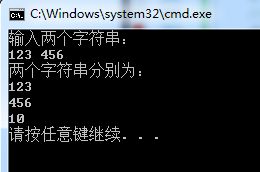
2、cin.get(字符数组名,接收长度,结束符)
其中结束符意味着遇到该符号结束字符串读取,默认为enter,读取的字符个数最多为(长度 - 1),因为最后一个为'\0'。要注意的是,cin.get(字符数组名,接收长度,结束符)操作遇到结束符停止读取,但并不会将结束符从缓冲区丢弃。cin.get函数有如下几种声明:
int get();
istream& get(char& c);
istream& get(char* s, streamsize n);
istream& get(char* s, streamsize n, char delim);
istream& get(streambuf& sb);
istream& get(streambuf& sb, char delim);
(1)接收一个字符ch=cin.get()或cin.get(char ch),二者等价,看两个例子
cin.get()存在的基本目的,我认为就是为了从c移植到c++的时候,直接用cin.get()代替getchar(),也正因因此,cin.get()的返回值跟其它cin.get成员函数返回cin对象不同,跟getchar()一样返回int。所以cin.get()和C语言的getchar()没什么区别。
-
void test_input()
-
{
-
char ch1,ch2;
-
cout<<
"请输入两个字符:"<
-
cin.
get(ch1);
//或ch1 = cin.get();
-
cin.
get(ch2);
-
cout<
" "<
-
cout<<(
int)ch1<<
" "<<(
int)ch2<
-
}
来看几组测试:
-
连续输入ab[enter],结果正常,ch1,ch2分别读取了a、b,将其输出,然后在输出其ASCII值。要注意的是,以上输入并读取后,缓冲区中依然存在[Enter]没有被删除。

- 输入a[Space]b[Enter],结果在输出时,只看到了a,输出ASCII值时候分别为97 32(空格的ASCII值),这就说明cin.get()并不会舍弃Space,依然会将其读取进去,并加以显示等操作。

- 输入a[Enter],输出见下图。在输出a之后,第二次的输出产生了换行的效果,而输出的第二个ASCII值为10(Enter的ASCII值),这就进一步响应了前面说到的cin.get()遇到结束符并不会将之删除。
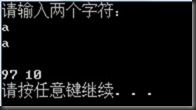
(2)接收一定长度的字符串cin.get(字符数组名,接收长度,结束符),结束符为可选参数,默认为Enter,可以接受Space 、Tab,对于结束符的处理要注意,结束符并不会丢掉,同样看几个例子。
- 对于如下代码,所做的操作时,在不遇到enter时最多读入(6-1)=5个字符到ch2中,然后读入下一个字符到ch1中,显示ch2,ch1以及其ASCII码值。附上几组测试:
-
void test_input()
-
{
-
char ch1,ch2[
10];
-
cout<<
"请输入字符串:"<
-
cin.
get(ch2,
6);
//在不遇到结束符的情况下,最多可接收6-1=5个字符到ch2中,注意结束符为默认Enter
-
cin.
get(ch1);
//或ch1 = cin.get();
-
cout<
-
cout<
"\n"<<(
int)ch1<
-
}
- 输入:zifuchuan[Enter],由于输入长度大于(6-1)=5,所以会首先读入“zifuc”到ch1,此时“huan”仍在缓冲区,当执行cin.get(ch1)会直接从缓冲区读入h,而不需要申请从键盘输入,看一下结果,符合分析。

- 输入:zifu[Enter],此时输入长度小于5就遇到了默认结束符Enter,则ch2中只读入“zifu”,要注意的是,输入缓冲区里面的Enter还在,所以接下来要读入的ch1的内容将是Enter,而输出时将看到换行,ASCII码值为10,见下图

- 输入:zi fuchuan[Enter],注意中间的空格,cin.get()对空格并不敏感,依然会读入,故而ch2读入的是“zi fu”,ch1读入的是c
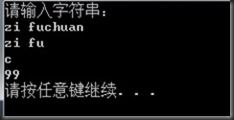
假如:
-
#include
-
using
namespace std;
-
-
int main()
-
{
-
char ch1, ch2[
10];
-
cout <<
"请输入字符串:" << endl;
-
cin.
get(ch2,
13);
//在不遇到结束符的情况下,最多可接收13-1=12个字符到ch2中,注意结束符为默认Enter
-
cin.
get(ch1);
//或ch1 = cin.get();
-
cout << ch2 << endl;
-
cout << ch1 <<
"\n" << (
int)ch1 << endl;
-
-
return
0;
-
}
输入:123456789(enter)
输出:
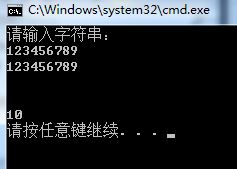
输入:1234567890(enter)
则VS2015运行报错!因为ch2[10]用cin.get最多接受9个字符,最后一个是'\0'。但g++ 5.4.0正常(说明没有对下标越界做检查)。


还有一点需要注意的是,cin.get(字符数组名,接收长度,结束符),当一开始第一个输入字符(即前面无其他任何字符)就遇到结束符情况下,将不会正常输出,但缓冲区中依然有该结束符。
例:
-
#include
-
using
namespace std;
-
-
int main()
-
{
-
char ch[
5], ch2;
-
cin.
get(ch,
3);
//默认结束符'\n',此处直接(enter)
-
cin.
get(ch2);
-
cout << ch2 <<
' ' << (
int)ch2 << endl;
//VS2015 输出-52, g++ 5.4.0 输出0
-
-
return
0;
-
}


以上程序如果输入1(enter),将正常输出\n的ASCII码,输出如下:


清除错误标志:
-
#include
-
using
namespace std;
-
-
int main()
-
{
-
char ch[
5], ch2;
-
cin.
get(ch,
3);
//默认结束符'\n',此处直接(enter)
-
cin.
clear();
//清除错误标志
-
cin.
get(ch2);
-
cout << ch2 <<
' ' << (
int)ch2 << endl;
-
-
return
0;
-
}
输出:

可见结束符依然在缓冲区当中。
再来一例:
-
#include
-
using
namespace std;
-
-
int main()
-
{
-
char ch[
5], ch2;
-
cin.
get(ch,
3,
'a');
// 结束符为'a',直接输入a(enter)
-
cin.
get(ch2);
-
cout << ch2 <<
' ' << (
int)ch2 << endl;
-
-
return
0;
-
}
输出:


如果输入1a(enter),输出如下:


清除错误标志:
-
#include
-
using
namespace std;
-
-
int main()
-
{
-
char ch[
5], ch2;
-
cin.
get(ch,
3,
'a');
// 结束符为'a',直接输入a(enter)
-
cin.
clear();
// 清除错误标志
-
cin.
get(ch2);
-
cout << ch2 <<
' ' << (
int)ch2 << endl;
-
-
return
0;
-
}
-
输出:

可见结束符'a'依然在缓冲区当中。
补充:cin.get(ch2)和ch2 = cin.get()小区别:
-
#include
-
using
namespace std;
-
-
int main()
-
{
-
char ch[
5], ch2;
-
cin.
get(ch,
3,
'a');
//此处输入a(enter)
-
ch2 = cin.
get();
//注意与cin.get(ch2)不同
-
cout << ch2 <<
' ' << (
int)ch2 << endl;
-
-
return
0;
-
}

(3)cin.get( ),注意此时没有参数,可用于舍弃输入流中的不需要的字符,或者舍弃回车,弥补cin.get(字符数组名,字符数目,结束符)的不足。对(2)中的代码加入一句话cin.get()如下:
-
void test_input()
-
{
-
char ch1,ch2[
10];
-
cout<<
"请输入字符串:"<
-
cin.
get(ch2,
6);
//在不遇到结束符的情况下,最多可接收6-1=5个字符到ch2中
-
cin.
get();
//注意:前面两句可以写到一块:cin.get(ch2,6).get();
-
cin.
get(ch1);
//或ch1 = cin.get();
-
cout<
-
cout<
"\n"<<(
int)ch1<
-
}
- 前面遇到的一个状况是,输入字符后,其结束符(如默认的Enter)会保留在缓冲区中,当下次读入时,又会再读入,此时就可以用到cin.get()读掉输入缓冲区不需要的字符,如:输入:zi[Enter],由于遇到结束符,所以ch2内容为zi,此时输入缓冲区还存在着[Enter],但cin.get()将其舍弃掉之后,cin.get(ch1)就会申请从键盘输入内容,如下所示:

3、cin.getline(字符数组名,接收长度,结束符)
其用法与cin.get(字符数组名,接收长度,结束符)极为类似。cin.get()当输入的字符串超长时,不会引起cin函数的错误,后面若有cin操作,会继续执行,只是直接从缓冲区中取数据。但是cin.getline()当输入超长时,会引起cin函数的错误,后面的cin操作将不再执行。如下代码:
-
-
void test_input()
-
{
-
char ch1,ch2[
10];
-
cout<<
"请输入字符串:"<
-
cin.
getline(ch2,
6);
//在不遇到结束符的情况下,最多可接收6-1=5个字符到ch2中
-
cin>>ch1;
-
cout<
-
cout<
"\n"<<(
int)ch1<
-
}
- 测试:如下图,输入zifuchuan[Enter],长度大于最大长度5,就会导致cin函数错误,其后既没有像cin.get()一样直接从输入缓冲区直接读数据,也没有从键盘输入。所以此处可以注意,考虑在用cin.getline()时,适度设置其最大接受长度大一点。


- 假如:
-
#include
-
using
namespace std;
-
-
int main()
-
{
-
char ch1, ch2[
6];
// 最多可接收5个,最后一个'\0'
-
cout <<
"请输入字符串:" << endl;
-
cin.
getline(ch2,
8);
//在不遇到结束符的情况下,最多可接收8-1=7个字符到ch2中
-
cin >> ch1;
-
cout << ch2 << endl;
-
cout << ch1 <<
"\n" << (
int)ch1 << endl;
-
-
return
0;
-
}
输入:123456(enter) VS将会报错,g++正常。说明VS对数组下标进行了检查。
- cin.get()每次读取一整行并把由Enter键生成的换行符留在输入队列中,然而cin.getline()每次读取一整行并把由Enter键生成的换行符抛弃,比如:
-
-
#include
-
using
namespace std;
-
-
int main() {
-
cout <<
"Enter your name:";
-
char name[
15];
-
//cin.get(name, 15);
-
cin.
getline(name,
15);
// 输入abc(enter)
-
cout <<
"name:" << name << endl;
-
char ch;
-
cin.
get(ch);
// 输入123(enter) 注:因为cin.getline把最后一个换行符丢弃了,所以此处ch读取字符'1'
-
cout << (
int)ch << endl;
//输出49 '1'的ASCII码值
-
cout <<
"\nEnter your address:";
-
char address[
15];
-
//cin.getline(address, 15);
-
cin.
get(address,
15);
//直接读取缓冲区剩余的23 注:cin.get保留最后一个换行符在缓冲区
-
cout <<
"address:" << address << endl;
-
cin.
get(ch);
// 读取缓冲区最后一个换行符
-
cout << (
int)ch << endl;
-
cin.
get(ch);
// 缓冲区已为空,所以从键盘输入a
-
cout << (
int)ch << endl;
//输出97 'a'的ASCII码值
-
return
0;
-
}

-
#include
-
using
namespace std;
-
-
int main() {
-
cout <<
"Enter your name:";
-
char name[
15];
-
cin.
get(name,
15);
// 输入abc(enter)
-
//cin.getline(name, 15);
-
cout <<
"name:" << name << endl;
-
char ch;
-
cin.
get(ch);
//因为cin.get不会丢弃最后一个换行符,所以此处ch读取换行符
-
cout << (
int)ch << endl;
//输出10 '\n'的ASCII码值
-
cout <<
"\nEnter your address:";
-
char address[
15];
-
cin.
getline(address,
15);
//输入123(enter)
-
//cin.get(address, 15);
-
cout <<
"address:" << address << endl;
-
cin.
get(ch);
// 因为cin.getline丢弃最后一个换行符,所以此处重新从键盘输入a(enter)
-
cout << (
int)ch << endl;
//输出97 'a'的ASCII码值
-
cin.
get(ch);
// cin.get不会丢弃最后一个换行符,所以此处读取上一步输入的保留在缓冲区的换行符
-
cout << (
int)ch << endl;
// 输出10 '\n'的ASCII码值
-
return
0;
-
}
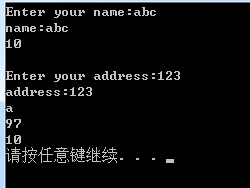
4、getline(istream is,string str,结束符)
同样,此处结束符为可选参数(默认依然为enter)。然而,getline()与前面的诸多存在的差别在于,它string库函数下,而非前面的istream流,所有调用前要在前面加入#include。与之对应这一方法读入时第二个参数为string类型,而不再是char*,要注意区别。另外,该方法也不是遇到空白字符(tab, space, enter(当结束符不是默认enter时))就结束输入的,且会丢弃最后一个换行符。
-
#include
-
#include
-
using
namespace std;
-
-
int main() {
-
char ch;
-
string str;
-
cout <<
"请输入string内容:" << endl;
-
getline(cin, str);
//输入:abc(space)(space)d(enter)
-
//getline(cin, str, 'a');
-
cout << str << endl;
-
cin.
get(ch);
//因为丢弃了最后一个换行符,所以此处从键盘输入b
-
cout << (
int)ch << endl;
//输出:98 'b'的ASCII码值
-
return
0;
-
}

-
#include
-
#include
-
using
namespace std;
-
-
int main() {
-
char ch;
-
string str;
-
cout <<
"请输入string内容:" << endl;
-
//getline(cin, str);
-
getline(cin, str,
'a');
//输入:string(enter)strinabc,遇到结束符'a'停止读取
-
cout << str << endl;
//输出string(enter)strin
-
cin.
get(ch);
//将缓冲区中'a'丢弃,读取'a'之后的'b'
-
cout << (
int)ch << endl;
//输出:98 'b'的ASCII码值
-
return
0;
-
}

5、getline和cin.getline区别
cin.getline()当输入超长时,会引起cin函数的错误,后面的cin操作将不再执行。
-
#include
-
using
namespace std;
-
-
int main()
-
{
-
char ch, a[
20];
-
cin.
getline(a,
5);
// 此处输入12345(enter)
-
cin >> ch;
-
cout << a << endl;
-
cout << (
int)ch << endl;
-
return
0;
-
}
输出:


这里的ch并没有读取缓冲区中的5,而是返回了-52(VS)/0(g++),这里其实cin>>ch语句没有执行,是因为cin出错了!我们经常会看到程序中会出现cin.clear(),cin.ignore(), cin.fail()等函数。这些函数都是与cin的错误处理有关的。这一节我们来分析一下cin的错误处理机制,并且学习几个重要的函数:cin.fail(), cin.bad(), cin.good(), cin.clear(), cin.ignore()等。程序执行时有一个标志变量来标志输入的异常状态,其中有三位标志位分别用来标志三种异常信息,他们分别是:failbit,eofbit,badbit。
ios类定义了这四个常量badbit, eofbit, failbit, goodbit,其实这四个标志常量就是取对应标志位的掩码,也即输入的四种异常情况!
以上四个常量在g++对应的取值为:
ios::badbit 001 输入(输出)流出现致命错误,不可挽回
ios::eofbit 010 已经到达文件尾
ios::failbit 100 输入(输出)流出现非致命错误,可挽回
ios::goodbit 000 流状态完全正常, 各异常标志位都为0
我们可以用输出语句来验证这几个常量的值:
cout << ios:: failbit << endl;
cout << ios:: eofbit << endl;
cout << ios:: badbit << endl;
cout << ios:: goodbit << endl;
g++输出的结果为:

VS下输出:

【注意】它们不是failbit、badbit、eofbit、goodbit这四个标记位的存贮变量,而是四个标志四种异常状态的常量,其实他们就相当于取对应状态标志位的掩码。如果标志变量为flag,则flag & failbit 就取得fail标志位。
搞清楚了标志位的原理后,我们来看几个关于异常标志的函数:
1、iostate ios::rdstate()
取标志变量的值,我们可以用该函数取得整个标志变量的值,再与前面定义的标志位常量相与就可以获得对应标志位的状态。如:
-
void TestFlags( ios& x ) // 获得x流的三个标志位状态
-
{
-
cout << ( x.
rdstate( ) & ios::badbit ) << endl;
-
cout << ( x.
rdstate( ) & ios::failbit ) << endl;
-
cout << ( x.
rdstate( ) & ios::eofbit ) << endl;
-
cout << endl;
-
}
2、bool ios::fail()const;
1 or true if rdstate & failbit is nonzero, otherwise 0 or false. (引用msdn)
其中rdstate即通过rdstate()取得的标识变量的值,与failbit相与,即取得failbit标志位的值,如果结果非零则放回true,否则返回false。即该函数返回failbit的状态,将标志位状态通过bool值返回。
3、bool ios::bad() const;
1 or true if rdstate & badbit is nonzero; otherwise 0. (引用msdn)
与fail()相似。
4、bool ios::good()const;
1 or true if rdstate == goodbit (no state flags are set), otherwise, 0 orfalse. (引用msdn)
改函数取goodbit的情况,即三个标志位都0(即没有任何异常情况)时返回true,否则返回false。
5、voidios::clear(iostate _State=goodbit);
该函数用来重置标识变量,_State是用来重置的值,默认为goodbit,即默认时将所有标志位清零。用户也可以传进参数,如:clear(failbit),这样就将标识变量置为failbit(即:001)。
我们一般是用它的默认值,当cin出现异常,我们用该函数将所有标志位重置。如果cin出现异常,没有重置标志的话没法执行下一次的cin操作。如上一节的程序2的测试二为什么第二次输入操作没有执行?程序8中 cin>>ch 为什么没有执行?都是这个原因!!!
所以经常在程序中使用 cin.clear(), 为了重置错误标志!
6、另外还有一个函数 void ios::setstate(iostate_State);
这个函数也是用来设置标识变量的,但与clear()不同。clear()是将所有标志清零,在置以参数新的标志。而该函数不清零其他的标志,而只是将参数对应的标志位置位。这个函数不是经常使用,这里不再赘述。
在搞清楚了这几个函数后,对cin输入操作的错误处理就有了比较深的了解了。下面我们回过头来看看上一节程序8的测试,因为第一次用getline()读取字符串超长,所以导致出现异常,大家可以查看一下标志位来验证一下!所以会导致后面的 cin>>ch 语句没有执行。那我们利用前面学习的clear()函数来强制重置错误标志,看看会出现什么情况呢?
-
#include
-
using
namespace std;
-
int main ()
-
{
-
char ch, str[
20];
-
cin.
getline(str,
5);
-
cout<<
"flag1:"<
good()<// 查看goodbit状态,即是否有异常
-
cin.
clear();
// 清除错误标志
-
cout<<
"flag1:"<
good()<// 清除标志后再查看异常状态
-
cin>>ch;
-
cout<<
"str:"<
-
cout<<
"ch :"<
-
return
0;
-
}
测试输入:
12345[Enter]
输出:
flag1:0 // good()返回false说明有异常
flag2:1 // good()返回true说明,clear()已经清除了错误标志
str:1234
ch :5
【分析】程序执行结束还是只执行了一次读操作,cin>>ch还是没有从键盘读取数据,但是与程序8中不同,这里打印了ch的值为'5',而且在cin>>ch之前已经清楚了错误标志,也就是cin>>ch的读操作实际上执行了。这就是前面讲的cin读取数据的原理:它是直接从输入缓冲区中取数据的。此例中,第一次输入"12345",而getline(str, 5)根据参数'5'只取缓冲区中的前4个字符,所以str取的是"1234",而字符'5'仍在缓冲区中,所以cin>>ch直接从缓冲区中取得数据,没有从键盘读取数据!
也就是当前一次读取数据出错后,如果缓冲区没有清空的话,重置错误标志还不够!要是能将缓冲区的残留数据清空了就好了哦!下面我们再来看一个很重要的函数!
7、basic_istream&ignore(streamsize _Count = 1, int_type _Delim = traits_type::eof());
function: Causes a number of elements to be skipped from the current readposition.
Parameters:
_Count, The number of elements to skip from the current read position.
_Delim, The element that, if encountered before count, causes ignore to returnand allowing all elements after _Delim to be read. (引用msdn)
这个函数用来丢弃输入缓冲区中的字符,第一参数定义一个数,第二个参数定义一个字符变量。下面解释一下函数是怎样执行的:函数不停的从缓冲区中取一个字符,并判断是不是_Delim,如果不是则丢弃并进行计数,当计数达到_Count退出,如果是则丢弃字符退出。例:cin.ignore(5, 'a'); 函数将不断从缓冲区中取一个字符丢弃,直到丢弃的字符数达到5或者读取的字符为'a'。下面我们看个程序例子:
-
#include
-
using
namespace std;
-
-
int main()
-
{
-
char ch;
-
cin.
ignore(
5,
'a');
-
cin.
get(ch);
-
cout << (
int)ch << endl;
-
return
0;
-
}
1.当输入:123456(enter)时,VS和g++都输出54(字符'6'的ASCII码)。如下所示:


2.当输入:b(enter)b(enter) b(enter) 时,VS和g++都输出10(即最后一个enter的ASCII码)。说明cin.ignore()会读取enter,如下所示:


3.但当输入:1234(enter)ab(enter)时,VS输出97('a'),g++输出98('b')。


也就是VS中cin.ignore()将第一个enter读取了,但g++中cin.ignore()未读取第一个enter,而是读取了第一个enter之后的'a'。
丢弃一个字符:
我们看看这个函数的默认值,第一个参数默认为1,第二个参数默认为EOF。所以cin.ignore()就是丢弃缓冲区中的第一个字符,这在程序中也是比较常用的!
-
#include
-
using
namespace std;
-
int main()
-
{
-
char c1, c2;
-
cin.
get(c1);
-
cin.
ignore();
// 用该函数的默认情况,丢弃一个字符,即上次输入结束的回车符
-
cin.
get(c2);
-
cout<
" "<// 打印两个字符
-
cout<<(
int)c1<<
" "<<(
int)c2<
// 打印这两个字符的ASCII值
-
return
0;
-
}
测试一输入:
a[Enter]
b[Enter]
输出:
a
b
97 98
【分析】这样程序就正常了!
清空整个缓冲区:
其实该函数最常用的方式是这样的,将第一个参数设的非常大,将第二个参数设为'\n',这样就可以缓冲区中回车符中的所有残留数据,因为一般情况下前面输入残留的数据是没有用的,所以在进行新一次输入操作前将缓冲区中所有数据清空是比较合理。
如:cin.ignore(1024, '\n');
或者:cin.ignore(std::numeric_limits::max(), '\n');
参考网址:
1. https://blog.csdn.net/livecoldsun/article/details/25489429
2.https://blog.csdn.net/xuexiacm/article/details/8101859#commentsedit